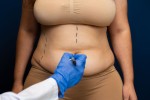Roux en Y gastric bypass is one of the most well-established weight loss surgeries available. It is especially recommended for people struggling with obesity and related conditions. For example diabetes or high blood pressure. Not only does it reduce stomach size. But it also changes how your digestive system absorbs food.
This guide explains everything you need to know about Roux en Y gastric bypass. Learn what it is, how it works and who it suits. Also learn what you can expect during recovery.
What Is Roux en Y Gastric Bypass?
Roux en Y gastric bypass is a type of bariatric surgery. It combines both restrictive and malabsorptive techniques to help you lose weight. Firstly, the surgeon creates a small pouch at the top of the stomach. This significantly limits how much food you can eat.
Secondly, the small intestine is divided. One section is connected to the pouch. This bypasses the rest of the stomach and upper intestine. This reduces calorie absorption and helps control hunger-related hormones.
This dual approach is why Roux en Y gastric bypass is so effective. Especially for long-term weight loss.
How Is the Procedure Performed?
The surgery is typically done using minimally invasive laparoscopic techniques. Small incisions are made. The surgeon uses a camera and tools to perform the procedure.
After the stomach pouch is created, the small intestine is rearranged into a Y-shaped configuration. One limb connects to the stomach pouch. The other carries digestive juices from the rest of the stomach and pancreas. They meet further down the intestine, allowing digestion to resume.
This design helps you feel full quickly and absorb fewer calories. This boosts weight loss and reduces hunger.
Who Is a Suitable Candidate?
Roux en Y gastric bypass is recommended for people with a BMI over 40. It may also suit those with a BMI over 35. Also those with a health condition related to obesity.
Ideal candidates are:
- Aged between 18 and 65
- Non-smokers or willing to quit
- Motivated to follow lifestyle changes
- Unsuccessful with diet and exercise alone
Additionally, the best results come from patients who commit to lifelong follow-up and support.
What Are the Benefits of Roux en Y Gastric Bypass?
This surgery offers several important benefits:
- Substantial weight loss: Patients usually lose 60–80% of excess weight within two years.
- Improved health: Conditions like Type 2 diabetes, high cholesterol and sleep apnoea often improve.
- Long-term success: Weight loss is typically sustainable for many years with the right lifestyle.
- Hormonal changes: Ghrelin, the hunger hormone, is reduced—helping appetite control.
Additionally, many patients report improved energy, mobility and confidence after the procedure.

What Is the Roux en Y Gastric Bypass Recovery Process Like?
Recovery after Roux en Y gastric bypass takes time and care. You’ll usually stay in hospital for two or three days. During this time, your team monitors healing and starts your post-op diet.
Most people return to light daily activities after two weeks. However, you should avoid heavy lifting and strenuous activity for six weeks.
Diet progresses from liquids to pureed, then soft, then solid foods over several weeks. You’ll also begin vitamin supplements to prevent nutrient deficiencies.
Long-term follow-up includes regular check-ups, blood tests and support from a dietitian or nutritionist.
What Can You Eat After the Roux en Y Gastric Bypass Surgery?
Eating habits change significantly after surgery. The new stomach pouch can only hold small amounts of food. Therefore, meals must be small, protein-rich and eaten slowly.
Here’s how your diet usually progresses:
- Week 1–2: Clear liquids only
- Week 3–4: Pureed foods and protein shakes
- Week 5–6: Soft foods like mashed vegetables or eggs
- Week 7 onward: Solid foods in small portions
Sugar and fatty foods should be avoided to prevent digestive discomfort and dumping syndrome.
How Does Roux en Y Gastric Bypass Compare to Other Surgeries?
Compared to gastric sleeve, Roux en Y gastric bypass causes greater hormonal changes. Also it typically creates more weight loss. It also improves Type 2 diabetes more effectively.
However, it is a more complex procedure, and recovery can take slightly longer. Unlike the adjustable gastric band, this surgery is permanent and doesn’t require future adjustments.
Gastric bypass is generally preferred when patients have severe metabolic issues, reflux, or higher BMI.
How Much Does Roux en Y Gastric Bypass Cost?
In the UK or US, the surgery typically costs between £9,000 and £15,000. This depends on the hospital and package inclusions. In Turkey, many clinics offer Roux en Y gastric bypass surgery. This costs from around £3,500 to £6,000. These packages often include hospital stay, medication, transport and hotel accommodation.
Turkey’s popularity is growing due to skilled surgeons, modern hospitals and all-inclusive pricing.
What Are the Long-Term Outcomes?
Long-term success depends on lifestyle habits. Most patients maintain significant weight loss and health improvements for many years.
However, if you return to unhealthy eating or stop exercising, weight regain is possible. That’s why long-term support, education and motivation are crucial.
With commitment, the benefits can last a lifetime. Enhancing not just your weight, but also your overall health and well-being.
How to Prepare for Surgery?
Before surgery, your doctor may recommend a diet to reduce liver size and improve safety. You’ll also undergo blood tests, scans and an anaesthetic assessment.
You may need to stop certain medications and avoid smoking. Preparing your home for recovery is important. Stock up on liquids, arrange help and clear space for rest.
Mentally, it helps to set realistic goals and plan for follow-up care. Education is key to long-term success.
Conclusion
Roux en Y gastric bypass is a trusted, effective weight loss procedure. It transforms both health and lifestyle. It works by reducing stomach size and changing digestion. Resulting in lasting weight loss and health improvements. Although recovery takes time, most patients find the long-term benefits worth the effort.
Whether you’re exploring surgery in the UK or abroad. Make sure to choose a qualified, experienced team. With the right support and commitment, this procedure can mark a turning point.
For more information and to book a consultation visit the ACIBADEM Beauty Center Obesity Surgery webpage.
Frequently Asked Questions
Yes, it is a permanent procedure that alters your digestive system for lasting weight loss.
Yes, lifelong supplements are essential to prevent vitamin and mineral deficiencies.
Weight loss begins within weeks and typically continues for 12–18 months post-surgery.
Yes, it often results in complete or partial remission of Type 2 diabetes.
The “Y” refers to the shape of the small intestine after rerouting during surgery.














